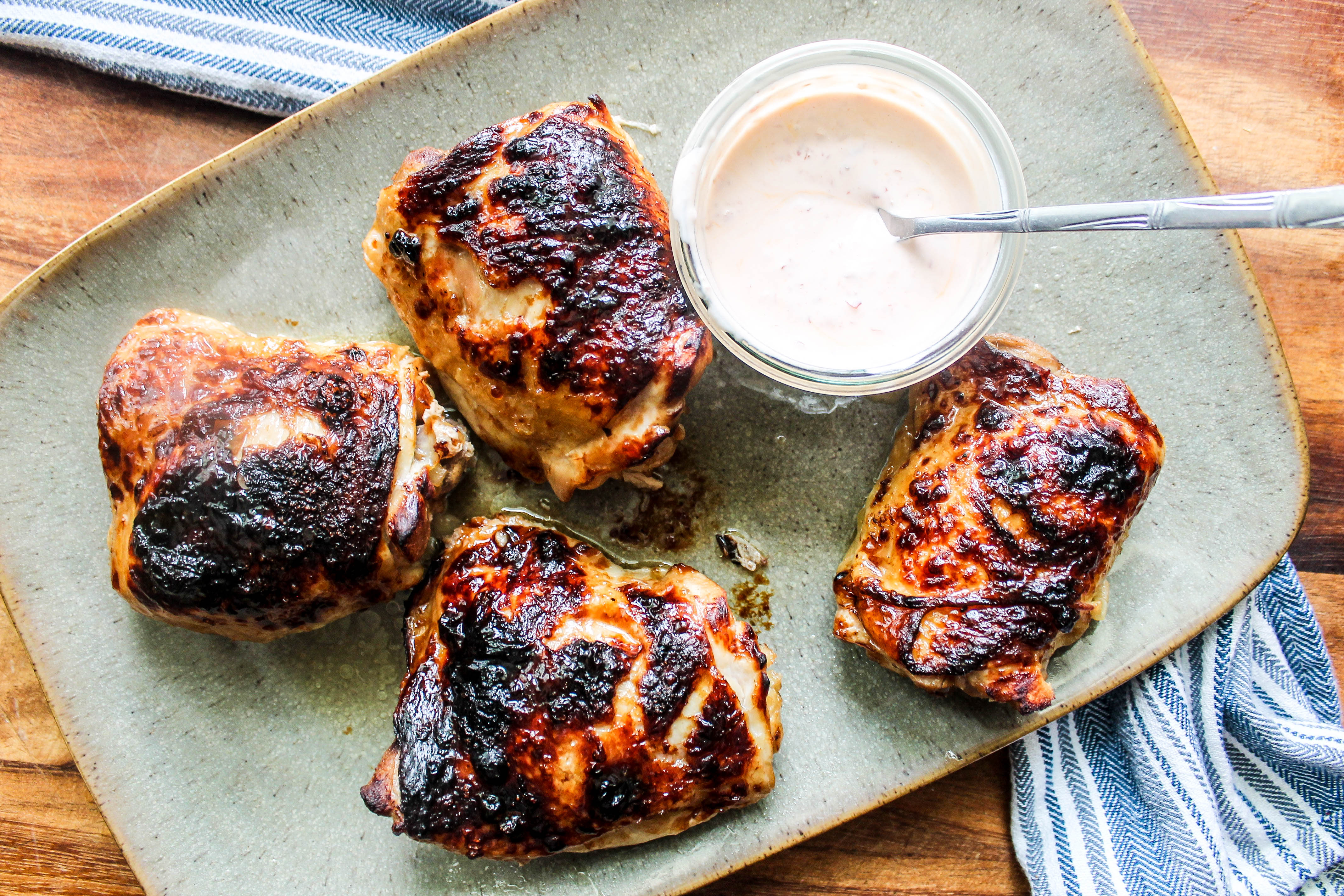 We all have our chef, cooking/baking guru crushes, don’t we? One of Kyle’s chef crushes is Yotam Ottolenghi. Ottolenghi’s book, Plenty, is basically the vegetarian cooking bible. Kyle’s admiration stems from his many inventive recipes, gorgeous photographs, and his extraordinary, yet sometimes unfamiliar, ingredients. In fact, his recipes have inspired many of our Allons-Eat! recipes, such as, Roasted Beet Puree with Za’atar, Fresh Corn Polenta with Eggplant Sauce, and, most recently, the Chocolate Tahini Chess Pie Bars.
We all have our chef, cooking/baking guru crushes, don’t we? One of Kyle’s chef crushes is Yotam Ottolenghi. Ottolenghi’s book, Plenty, is basically the vegetarian cooking bible. Kyle’s admiration stems from his many inventive recipes, gorgeous photographs, and his extraordinary, yet sometimes unfamiliar, ingredients. In fact, his recipes have inspired many of our Allons-Eat! recipes, such as, Roasted Beet Puree with Za’atar, Fresh Corn Polenta with Eggplant Sauce, and, most recently, the Chocolate Tahini Chess Pie Bars.
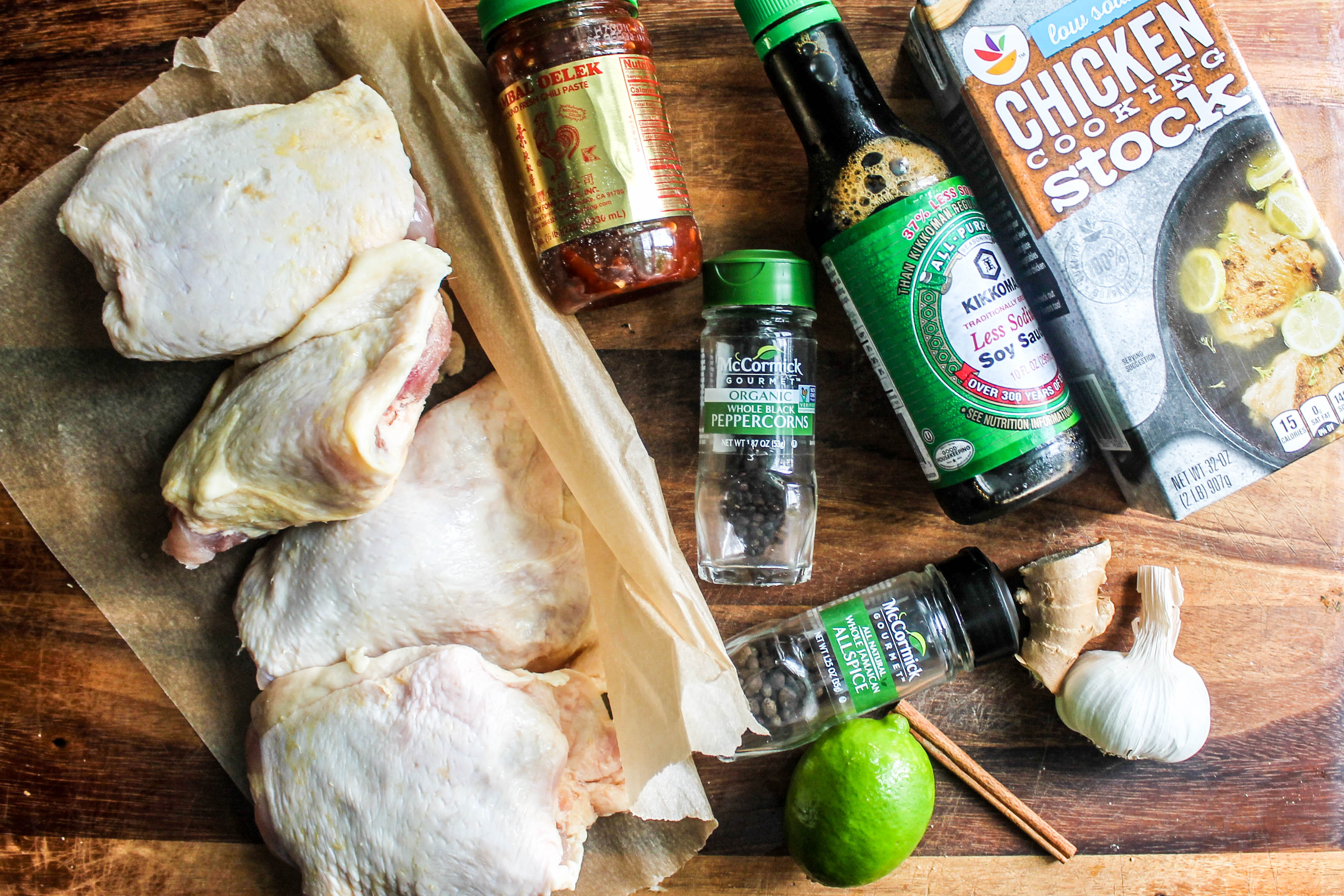 While Kyle was in London he had a visit to any Ottolenghi restaurant at the very top of his Dining Out Wish List. Luckily, Kyle and his friends snagged a reservation at NOPI, Ottolenghi’s two-story restaurant located in the swanky SoHo neighborhood. The upper floor offers a more traditional design – tables for parties of 2-6 people in an intimate setting – perfect for date night or for group celebrations. The lower level was designed with long communal tables right outside of the restaurant’s kitchen, offering a cozy atmosphere with a glance at the goings-on in the kitchen.
While Kyle was in London he had a visit to any Ottolenghi restaurant at the very top of his Dining Out Wish List. Luckily, Kyle and his friends snagged a reservation at NOPI, Ottolenghi’s two-story restaurant located in the swanky SoHo neighborhood. The upper floor offers a more traditional design – tables for parties of 2-6 people in an intimate setting – perfect for date night or for group celebrations. The lower level was designed with long communal tables right outside of the restaurant’s kitchen, offering a cozy atmosphere with a glance at the goings-on in the kitchen.
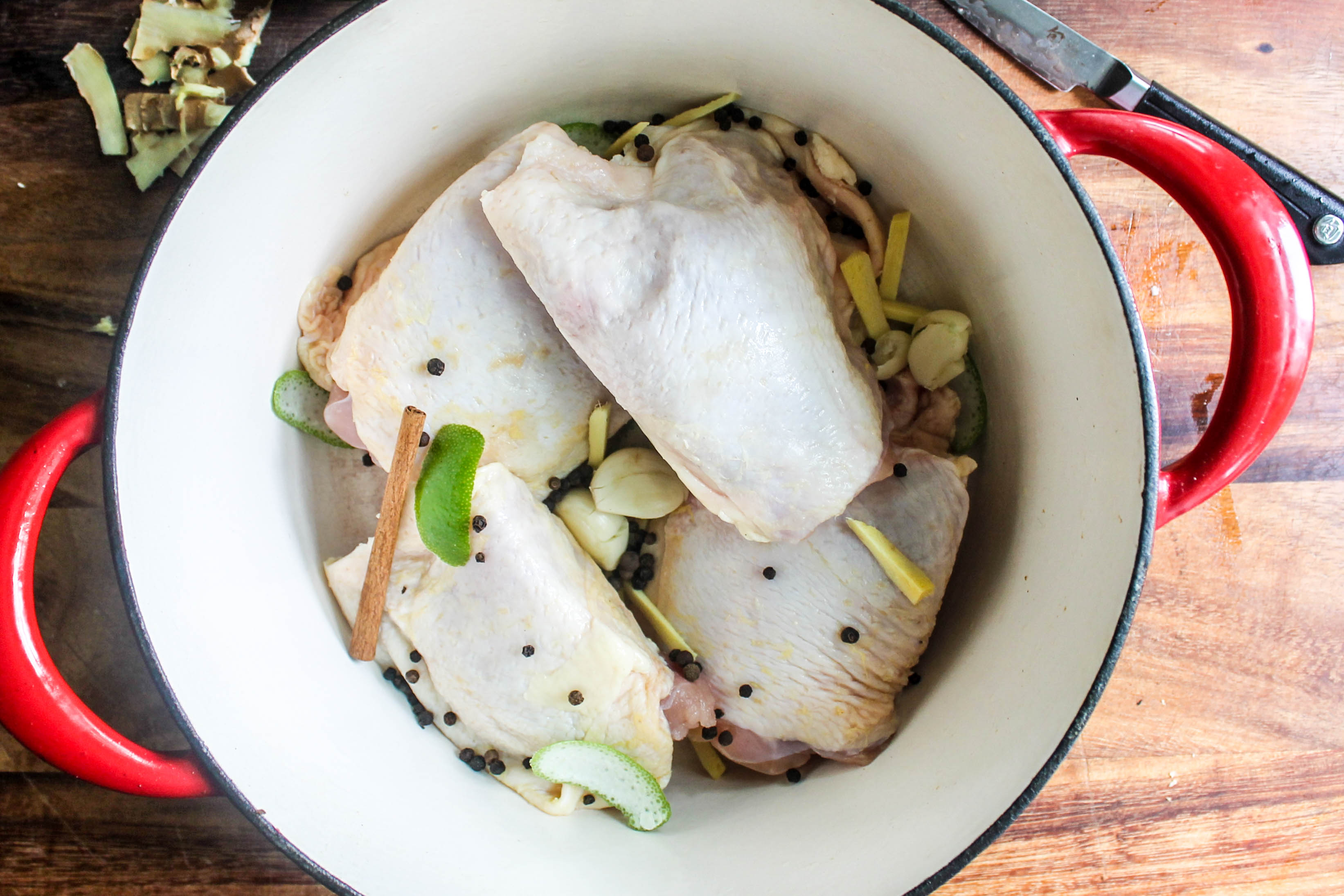 Kyle’s group opted for the atmosphere of the lower level at NOPI. They loved the feel of the unique dining expereince. The walls were lined with shelves full of their dry-storage and pantry goods, which, when combined with the open kitchen nearby and the long communal tables, really gave one the feeling of being a part of the behind-the-scenes action of the restaurant. Being seated with other parties gave them the opportunity to make new friends and gave the option of glancing at all the dishes of the nearby patrons, helping with the ordering process immensely.
Kyle’s group opted for the atmosphere of the lower level at NOPI. They loved the feel of the unique dining expereince. The walls were lined with shelves full of their dry-storage and pantry goods, which, when combined with the open kitchen nearby and the long communal tables, really gave one the feeling of being a part of the behind-the-scenes action of the restaurant. Being seated with other parties gave them the opportunity to make new friends and gave the option of glancing at all the dishes of the nearby patrons, helping with the ordering process immensely.
 The food and drinks definitley exceeded all of their expectations! Some of the stand out dishes they feasted on were burrata with blood orange segments and roasted coriander seeds, roasted eggplant stuffed with feta, pistachio and yogurt, and a seared duck breast with hazelnut beer butter. Alas- this post is dedicated to one of the menu items that they did not have the opportunity to taste in London – they only viewed the dish for a moment. Since the restaurant is tapas style, many of the items are small and shareable plates. There is no precise order to the arrival of the dishes – they are delivered as they are finished by the kitchen. About halfway through their meal a server dropped off a plate of the Twice-Cooked Chicken, an order that was not for them. It consisted of a roasted half-chicken with beautifully browned skin and a enticing aroma. The presentation made them wish they had ordered it themselves. With much regret they informed the server of the mix-up and vowed they would order a plate of the Twice-Cooked Chicken if they were not completely stuffed at the end of their meal. Cut to the end of their meal – they were FULL. To console the group, Kyle made a promise to research and recreate the dish when they got home.
The food and drinks definitley exceeded all of their expectations! Some of the stand out dishes they feasted on were burrata with blood orange segments and roasted coriander seeds, roasted eggplant stuffed with feta, pistachio and yogurt, and a seared duck breast with hazelnut beer butter. Alas- this post is dedicated to one of the menu items that they did not have the opportunity to taste in London – they only viewed the dish for a moment. Since the restaurant is tapas style, many of the items are small and shareable plates. There is no precise order to the arrival of the dishes – they are delivered as they are finished by the kitchen. About halfway through their meal a server dropped off a plate of the Twice-Cooked Chicken, an order that was not for them. It consisted of a roasted half-chicken with beautifully browned skin and a enticing aroma. The presentation made them wish they had ordered it themselves. With much regret they informed the server of the mix-up and vowed they would order a plate of the Twice-Cooked Chicken if they were not completely stuffed at the end of their meal. Cut to the end of their meal – they were FULL. To console the group, Kyle made a promise to research and recreate the dish when they got home.
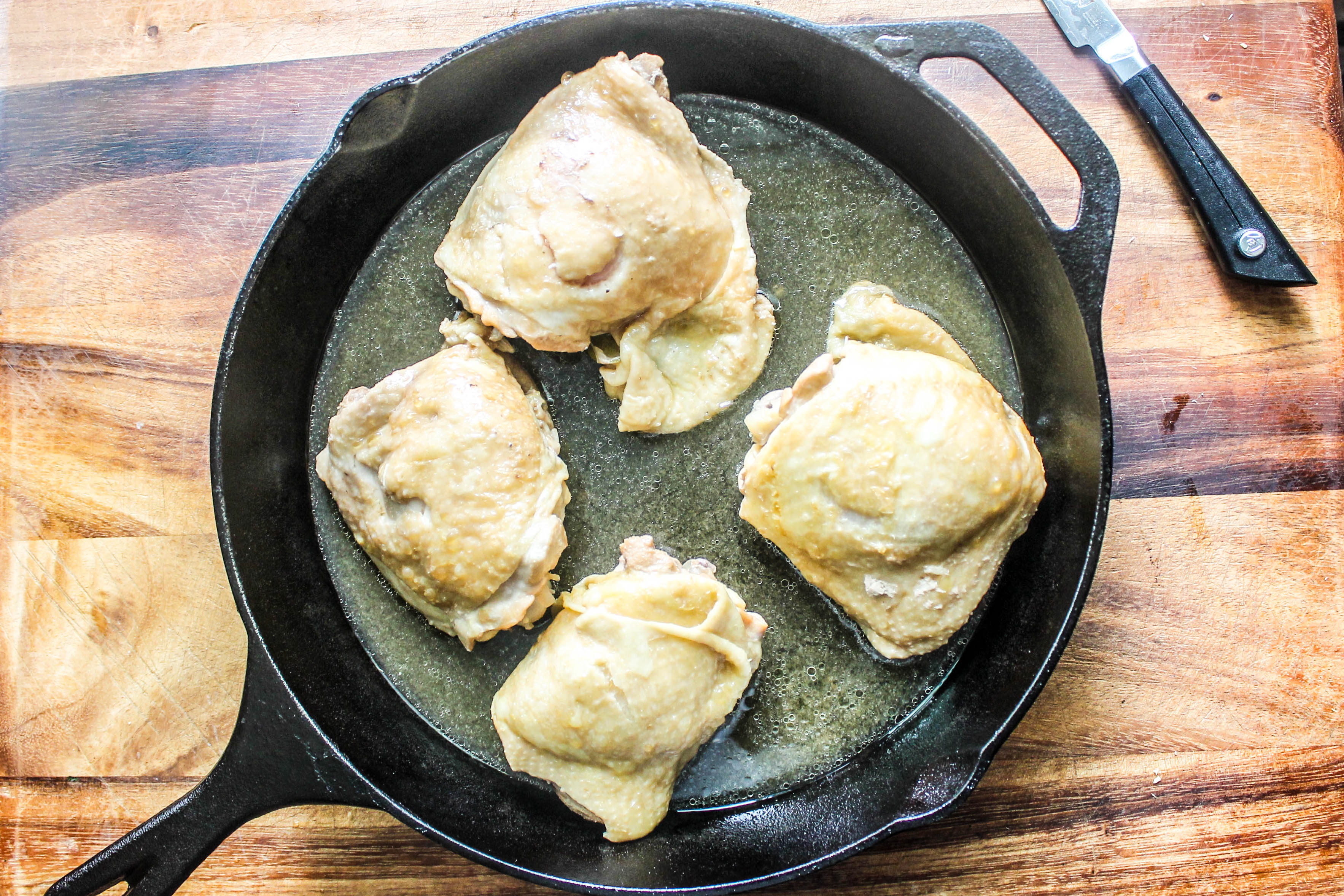 Luckily, the NOPI cookbook contained the recipe for Twice-Cooked Chicken since it is one of their signature dishes. In fact, it is practically guaranteed to be on the menu year-round. NOPI: The Cookbook contains a disclaimer from Ottolenghi about the recipes within this particular cookbook. The recipes are more challenging, restaurant-level recipes that are a collaboration of an entire kitchen staff, instead of his usual cookbook recipes that are designed for a single home cook. A challenge, eh? Challenge accepted. However, Kyle wanted to forge a streamlined path to NOPI’s Twice-Cooked Chicken, transforming the recipe in a more accessible, home-cooked type of dish.
Luckily, the NOPI cookbook contained the recipe for Twice-Cooked Chicken since it is one of their signature dishes. In fact, it is practically guaranteed to be on the menu year-round. NOPI: The Cookbook contains a disclaimer from Ottolenghi about the recipes within this particular cookbook. The recipes are more challenging, restaurant-level recipes that are a collaboration of an entire kitchen staff, instead of his usual cookbook recipes that are designed for a single home cook. A challenge, eh? Challenge accepted. However, Kyle wanted to forge a streamlined path to NOPI’s Twice-Cooked Chicken, transforming the recipe in a more accessible, home-cooked type of dish.
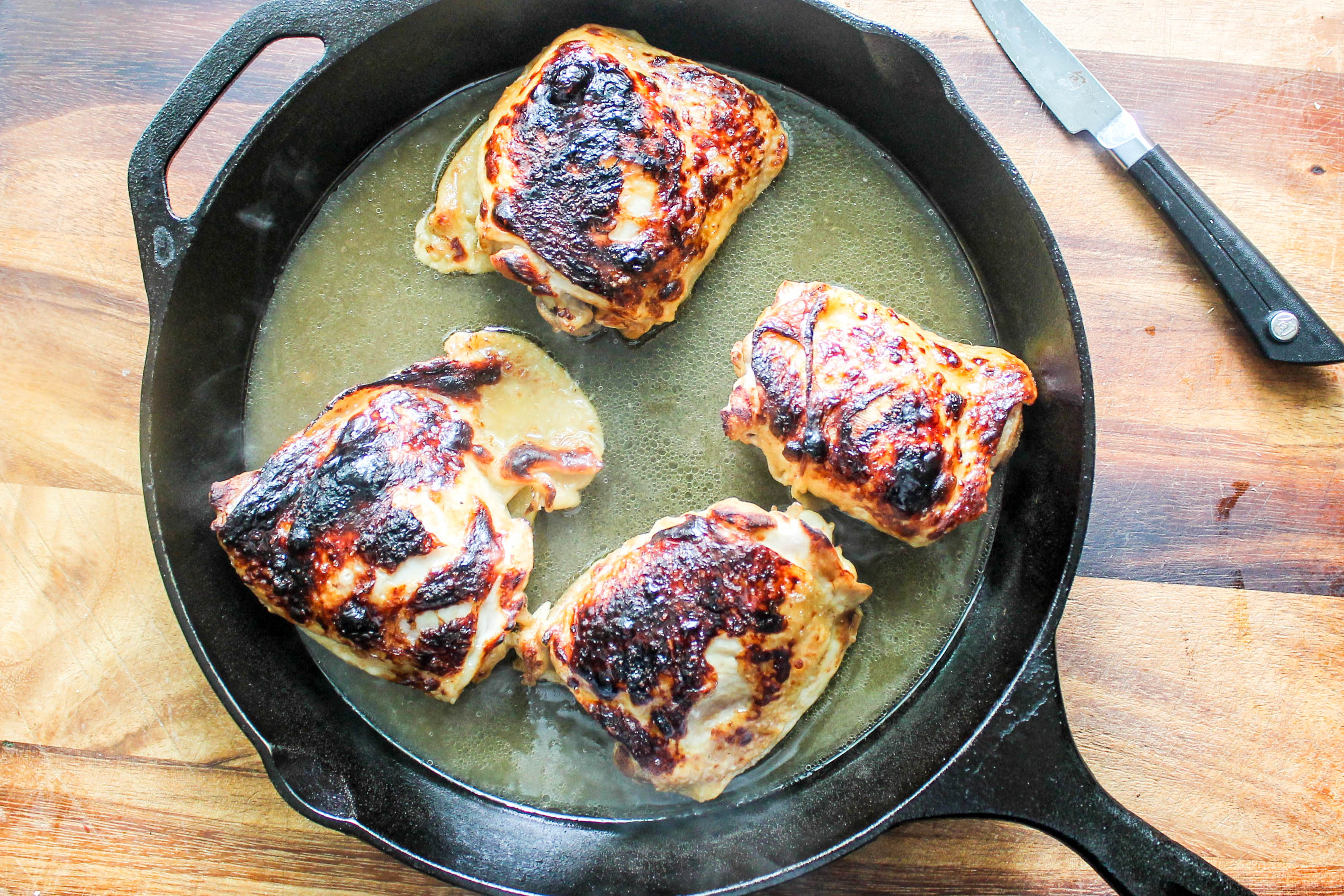 In the NOPI recipe, before you even prep the chicken, you are directed to a recipe for an “Asian Master Stock”, which, after it is prepared and cooled will serve as the poaching liquid for the chicken during the first step of the cooking process. Instead, Kyle swapped the ingredients for the Asian Master Stock with similar, but more readily available ingredients (black peppercorns for the Szechuan peppercorns; fennel seeds for the star anise; rice vinegar or the Shaoxing rice wine). For the first step in Kyle’s twice-cooked process, the substituted ingredients were then poached with the chicken in plain old chicken stock, infusing the dish with those flavor elements while eliminating the creation of the Asian Master Stock step. As an added bonus when making this dish, you will have a few cups of the makeshift Asian Master Stock leftover. It makes a killer cooking liquid for rice and other grains and can be used as a braising liquid for beef or even another type of chicken dish.
In the NOPI recipe, before you even prep the chicken, you are directed to a recipe for an “Asian Master Stock”, which, after it is prepared and cooled will serve as the poaching liquid for the chicken during the first step of the cooking process. Instead, Kyle swapped the ingredients for the Asian Master Stock with similar, but more readily available ingredients (black peppercorns for the Szechuan peppercorns; fennel seeds for the star anise; rice vinegar or the Shaoxing rice wine). For the first step in Kyle’s twice-cooked process, the substituted ingredients were then poached with the chicken in plain old chicken stock, infusing the dish with those flavor elements while eliminating the creation of the Asian Master Stock step. As an added bonus when making this dish, you will have a few cups of the makeshift Asian Master Stock leftover. It makes a killer cooking liquid for rice and other grains and can be used as a braising liquid for beef or even another type of chicken dish.
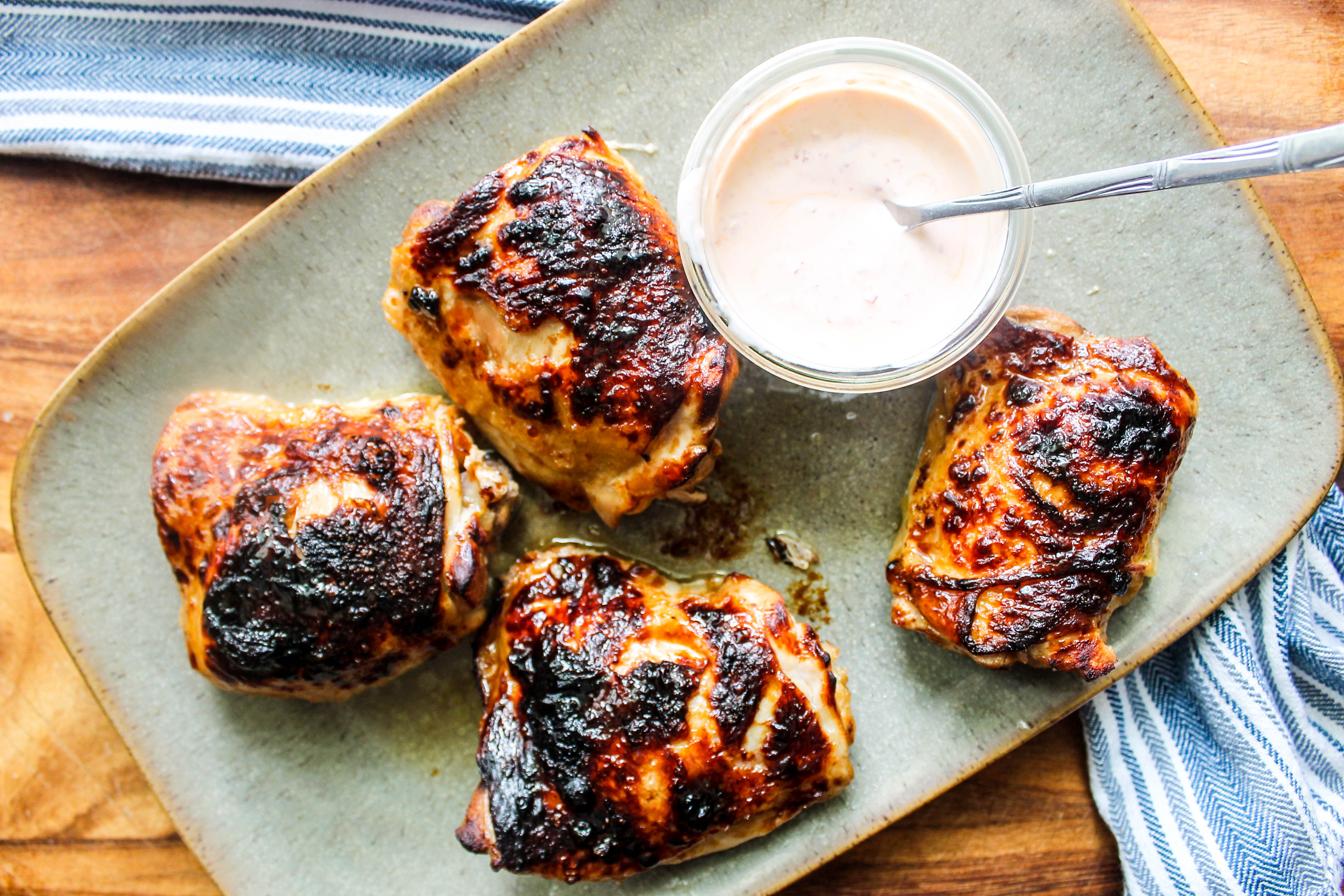 Several other steps were removed from the original process – mainly any step including marinating and waiting. He immediately broiled the poached chicken to get the superlatively bronzed and crispy skin that he had loved ogling at the NOPI restaurant in London. You don’t necessarily have to broil the chicken right away. Feel free to chill the chicken after poaching, completing the broiling step when you are ready to serve – it is a great make-ahead dish. The NOPI cookbook also pairs its chicken with a homemade chili paste. Kyle streamlined this step too – making a spicy (and cooling) dipping sauce with sambal oelek (sriracha or any other chili paste would also work) and Greek yogurt. The combination of gentle poaching and high-heat broiling produces a dish that contains both moist and tender meat with irresistible crackly skin.
Several other steps were removed from the original process – mainly any step including marinating and waiting. He immediately broiled the poached chicken to get the superlatively bronzed and crispy skin that he had loved ogling at the NOPI restaurant in London. You don’t necessarily have to broil the chicken right away. Feel free to chill the chicken after poaching, completing the broiling step when you are ready to serve – it is a great make-ahead dish. The NOPI cookbook also pairs its chicken with a homemade chili paste. Kyle streamlined this step too – making a spicy (and cooling) dipping sauce with sambal oelek (sriracha or any other chili paste would also work) and Greek yogurt. The combination of gentle poaching and high-heat broiling produces a dish that contains both moist and tender meat with irresistible crackly skin.
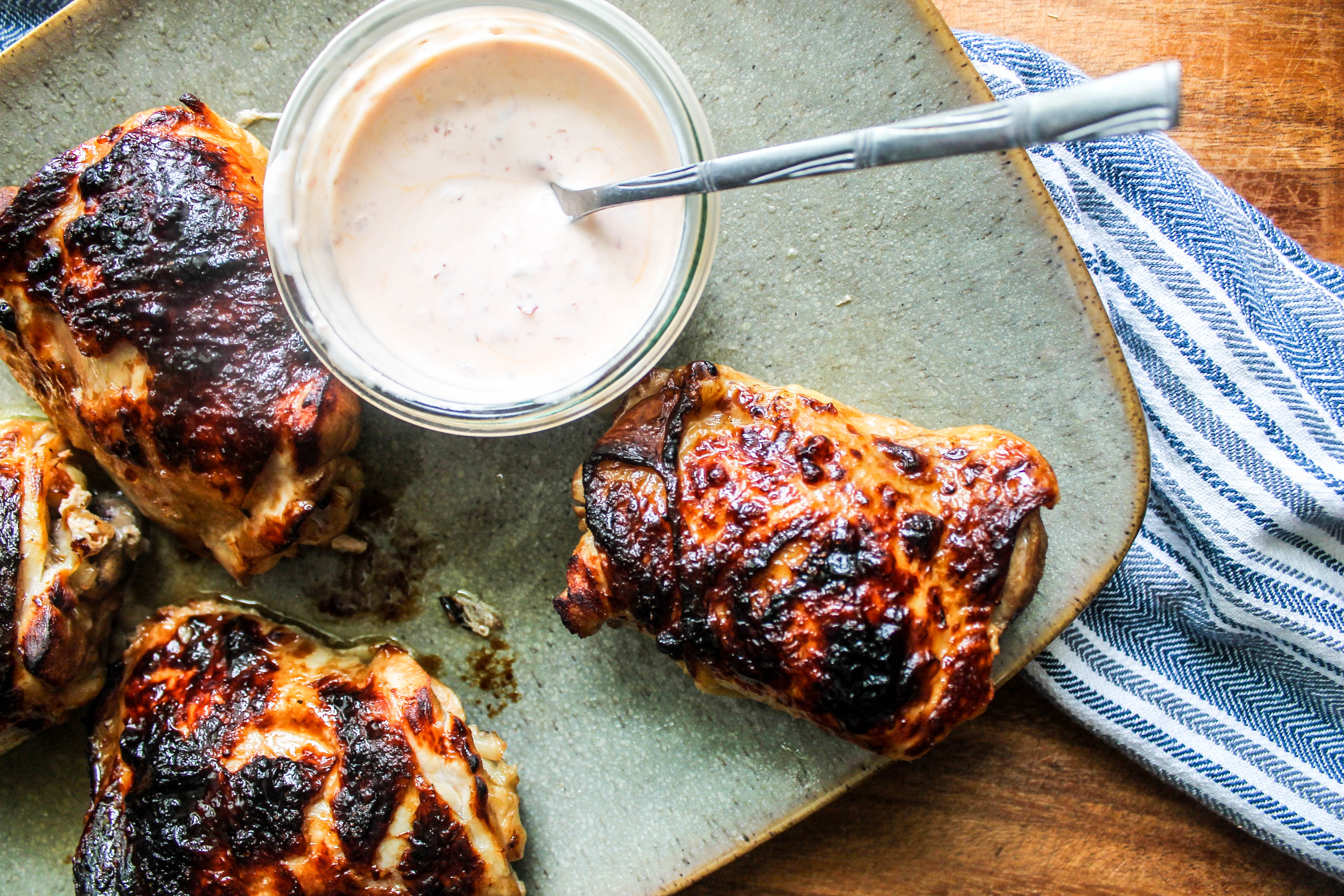 Chicken thighs were used for this recipe, as pictured, but chicken quarters, chicken legs, or butterflied poussins (the fancy ingredient the original recipe called for) would all be delicious following this technique. Since grilling season is finally here, you could poach the chicken and then finish the “broiling” step right on the grill, chicken skin-side down. It most certainly will put the more traditional grilled chicken to shame!
Chicken thighs were used for this recipe, as pictured, but chicken quarters, chicken legs, or butterflied poussins (the fancy ingredient the original recipe called for) would all be delicious following this technique. Since grilling season is finally here, you could poach the chicken and then finish the “broiling” step right on the grill, chicken skin-side down. It most certainly will put the more traditional grilled chicken to shame!
Adapted from NOPI: The Cookbook.
- For the chicken:
- 4 cups chicken stock (preferable low-sodium)
- ⅓ cup gluten free soy sauce
- ¼ cup rice vinegar (white wine vinegar works great too)
- 2-inch piece of ginger, peeled and thinly sliced
- 4 garlic cloves, peeled and thinly sliced
- 1 cinnamon stick
- 2 tablespoons honey
- 1 ½ teaspoons whole peppercorns
- ½ teaspoon allspice berries
- 1 lime, peeled
- 3 pounds chicken thighs or chicken quarters, skins on
- For the sauce:
- 1 tablespoon sambal oelek
- 1 tablespoon mayonnaise
- 2 tablespoons sour cream or greek yogurt
- Add chicken stock, soy sauce, vinegar, ginger, garlic, cinnamon, honey, peppercorns, allspice, lime peel (reserve the rest of the lime for later), and chicken to a large stockpot. Lay a piece of parchment paper on top of the stock and place a plate on top of that, to keep the chicken submerged in the liquid.
- Bring liquid to a boil over medium-high heat, then reduce heat to medium-low. Cook gently for 25 to 30 minutes, until a meat thermometer inserted into the thickest part of the chicken reads 165 degrees F (Alternatively, remove a piece of chicken from the pot and cut into it to check for doneness). Once chicken is cooked, remove it from the pot with tongs. (Strain the stock through a fine mesh sieve and allow to cool to room temperature for refrigerating. Reserve for another use - this stock makes a delicious base for rice, braised dishes, or even poaching vegetables).
- While the chicken simmers, prepare the sauce by whisking the sambal oelek, mayonnaise, and sour cream in a small bowl.
- Preheat the broiler to high. Place the chicken - skin side up - in a cast iron skillet or other ovenproof baking dish. Broil for 2 to 3 minutes, until the skin is dark brown and crispy (Watch closely while broiling, as the chicken can burn very quickly!). Alternatively, you can brown the chicken on a well-oiled grill, skin side down, over medium heat for 5 to 6 minutes.
- Serve the chicken with the spicy sambal oelek sauce and reserved lime wedges.

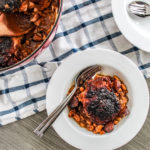
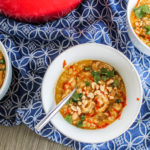
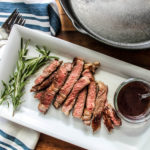
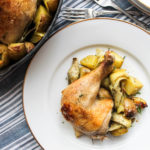
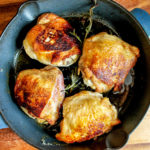
Leave a Reply